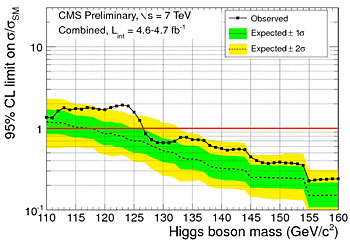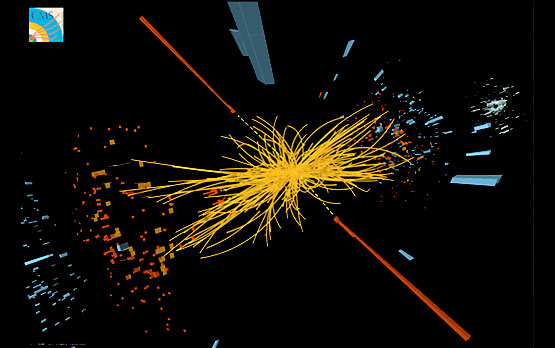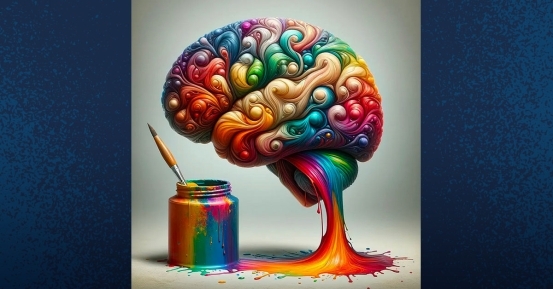
Hints of the Higgs Boson Seen as Trap Set for the Elusive Particle Tightens
By:
- Susan Brown
Published Date
By:
- Susan Brown
Share This:
Article Content
Physicists announced today that they may have caught glimpses of the Higgs boson, but the signals they see are not yet robust enough to meet the stringent requirements they have set for announcing an official discovery.
Vivek Sharma, professor of physics at the University of California, San Diego, leads one of the two separate teams searching for the Higgs at the Large Hadron Collider. Both teams have just finished analyzing the results from a run of collisions that ended in late October.
Although they can’t yet say whether or not the Higgs boson exists, the physicists have tightened their trap.
“We have enough data to do an incredible job in narrowing down the possible range of masses for the Higgs. There is now only a tiny sliver left where it can be hiding,” said Frank Wuerthwein, professor of physics and one of more than two dozen faculty, staff researchers and students at UC San Diego, involved in the search.
Within the remaining limited region where the Higgs might still be found, both teams have seen hints of what may turn out to be the elusive particle once more data is collected.
The Higgs boson is the last missing piece of physicists’ Standard Model of subatomic particles, which describes the basic elements of matter and the forces through which they interact. Its existence is critical to the most widely accepted explanation for how particles gain mass. Without it, physicists would need to rethink this central theory.
When protons collide
Catching the Higgs boson is tricky. In theory, slamming protons together at high energies will create a Higgs boson some of the time, but the boson would disintegrate right away in a spray of subatomic particles. Scientists must collect the debris to reconstruct what happened.

A bump in these data, where the black line for observations rises above the yellow shading, intrigues physicists. It will need to rise higher above the noise floor before they'll claim a discovery. Image: CMS/CERN
A Higgs boson could decay in five different ways to produce pairs of photons, W or Z bosons, tau leptons or heavy quarks. Two instruments at the LHC, called CMS and ATLAS, are designed to detect these well-known particles.
The trouble is, other physical processes can produce the same kinds of particle sprays. Yet independent teams operating each of the instruments have consistently recorded all of these kinds of events more often than expected, which could be a sign of the Higgs.
To be sure they’re not mistaking a random fluctuation for the Higgs, the scientists have set a high standard that must be reached before they will decide that the Higgs boson does or doesn’t exist. More observations, which they will begin to accumulate again once proton collisions resume in March 2012, will reduce the statistical uncertainty.
“We should get at least three times the amount of data we have now with slightly higher energies – a significantly better reach,” Wuerthwein said. “If life is just and all happens according to plans, we should know whether the standard model Higgs exists next year.”
Narrowed focus
Not only will the teams be working with more powerful collisions next year, they will also have better aim. This summer, they ruled out the possibility of a Higgs boson with a mass over most of its possible range. The new analysis of data collected since then both increased their confidence in this and has allowed them to further narrow their focus.
In a report issued today, the CMS team excludes all but the narrow range between 115 and 127 GeV (giga-electronvolts, the unit particle physicists use to measure mass), to at least the 95% confidence level. That means that the Higgs boson described by the Standard Model would yeild more evidence than they have observed at least 95 percent of the time in a set of repeated experiments.
Nothing would hang together – not atoms, not us – without mass. So if they fail to find a particle that matches the properties the Standard Model ascribes to the Higgs, physicists will have to revise their ideas about the forces that allow us and the rest of the universe to exist.
Share This:
You May Also Like
Stay in the Know
Keep up with all the latest from UC San Diego. Subscribe to the newsletter today.



